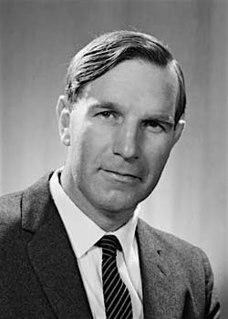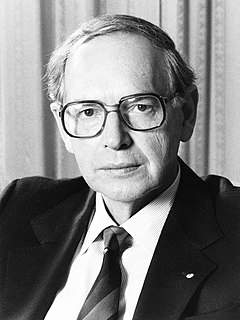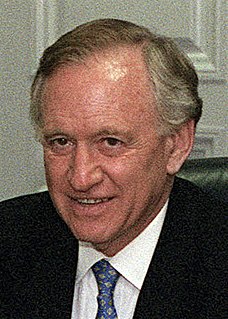The National Party of Australia is an Australian political party. Traditionally representing graziers, farmers, and rural voters generally, it began as the Australian Country Party in 1920 at a federal level. It would later briefly adopt the name National Country Party in 1975, before adopting its current name in 1982.

Ian McCahon Sinclair is a former Australian politician who served as leader of the National Party from 1984 to 1989. He was a government minister under six different prime ministers, and later Speaker of the House of Representatives from March to November 1998.

The 1996 Australian federal election was held to determine the members of the 38th Parliament of Australia. It was held on 2 March 1996. All 148 seats of the House of Representatives and 40 seats of the 76-seat Senate were up for election. The centre-right Liberal/National Coalition led by Opposition Leader John Howard of the Liberal Party and coalition partner Tim Fischer of the National Party defeated the incumbent centre-left Australian Labor Party government led by Prime Minister Paul Keating.
The Joh for Canberra campaign, initially known as the "Joh for PM" campaign, was an attempt by Queensland National Party premier Sir Joh Bjelke-Petersen to become Prime Minister of Australia. The campaign was announced in January 1987 and drew substantial support from Queensland businessmen and some conservative politicians. The campaign succeeded in causing a split in the federal Coalition. It did not attract widespread support and collapsed in June 1987. The Australian Labor Party under Bob Hawke went on to win by an increased majority in the 1987 federal election, gaining its highest-ever number of seats. Bjelke-Petersen came under increasing scrutiny as the Fitzgerald Inquiry gained traction, and was forced out of politics altogether in December 1987.
Robert Edward Borbidge is a former Australian politician who served as the 35th Premier of Queensland from 1996 to 1998. He was the leader of the Queensland branch of the National Party, and was the last member of that party to serve as premier. His term as premier was contemporaneous with the rise of the One Nation Party of Pauline Hanson, which would see him lose office within two years.

The 1993 Australian federal election was held to determine the members of the 37th Parliament of Australia. It was held on 13 March 1993. All 147 seats of the House of Representatives and 40 seats of the 76-seat Senate were up for election. The incumbent centre-left Australian Labor Party government led by Prime Minister Paul Keating was re-elected to a fifth term, defeating the centre-right Liberal/National Coalition led by Opposition Leader John Hewson of the Liberal Party, and coalition partner Tim Fischer of the National Party.
The Bjelkemander was the term given to a system of malapportionment in the Australian state of Queensland in the 1970s and 1980s. Under the system, electorates were allocated to zones such as rural or metropolitan and electoral boundaries drawn so that rural electorates had about half as many voters as metropolitan ones. The Country Party, a rural-based party led by Joh Bjelke-Petersen, was able to govern uninhibited during this period due to the 'Bjelkemander'.

Federal elections were held in Australia on 24 March 1990. All 148 seats in the House of Representatives and 40 seats in the 76-member Senate were up for election. The incumbent Australian Labor Party led by Bob Hawke defeated the opposition Liberal Party of Australia led by Andrew Peacock with coalition partner the National Party of Australia led by Charles Blunt. The election saw the reelection of a Hawke government, the fourth successive term.
The following lists events that happened during 1987 in Australia.
The following lists events that happened during 1991 in Australia.
John Owen Stone is a former Australian politician and public servant. He served as Secretary to the Treasury between 1979 and 1984, and as a senator for Queensland representing the National Party from 1987 to 1990.

Elections were held in the Australian state of Queensland on 2 December 1989 to elect the 89 members of the state's Legislative Assembly. This was the first election following the downfall of seven-term premier Sir Joh Bjelke-Petersen at the end of 1987.
Elections were held in the Australian state of Queensland on 1 November 1986 to elect the 89 members of the state's Legislative Assembly. It followed a redistribution which increased the number of seats in the Assembly from 82 to 89.
Elections were held in the Australian state of Queensland on 22 October 1983 to elect the 82 members of the state's Legislative Assembly.
Terrence Anthony "Terry" White is an Australian pharmacist, businessman, and former politician. White achieved notoriety when, as Queensland state leader of the Liberal Party he terminated the longstanding coalition agreement between the Liberal Party and the National Party of Joh Bjelke-Petersen. In the ensuing election, the Liberals were badly defeated, and White was replaced as party leader. After leaving politics, he established a nationwide chain of pharmacies using a franchise model and became a widely respected businessman.
John Angus Mackenzie Innes was a Queensland politician and leader of the state Liberal Party.
The National Party, known as the Country Party until 1974, was a political party in Queensland, Australia, for much of the period from 1915 until 2008. Formed by the Queensland Farmers' Union and serving as the state branch of the National Party of Australia, it initially sought to represent the interests of the farmers but over time became a more general conservative political party in the state, leading to much debate about relations with other conservative parties and a string of mergers that were soon undone. From 1957 it held power as part of a coalition with the state Liberal Party until 1983 when the Liberals broke away and the Nationals continued to govern in their own right until defeat in 1989. The party formed another coalition with the Liberals that took power in 1996 but was defeated in 1998. After a further decade in opposition the two parties merged to form the Liberal National Party of Queensland.
The Liberal Party, originally the Queensland People's Party, was a political party in Queensland, Australia, from the Second World War until 2008. Initially formed as independent body in 1943, it became the Queensland division of the Liberal Party of Australia in 1949. Based predominantly in Brisbane and other cities in Queensland, from 1957 it held power as the junior party in a coalition with the state Country Party, later the National Party, until 1983 when the Liberals broke away and went into opposition. The party formed another coalition with the Nationals that took power in 1996 but was defeated in 1998. After a further decade in opposition the two parties merged to form the Liberal National Party of Queensland.




















